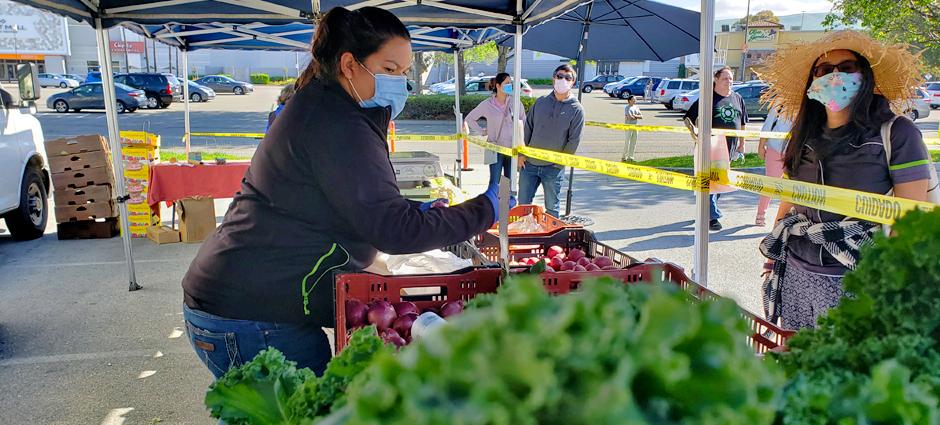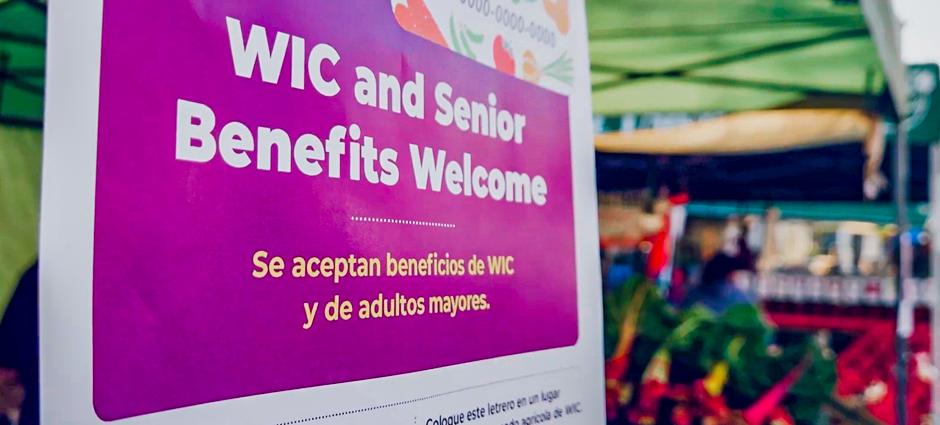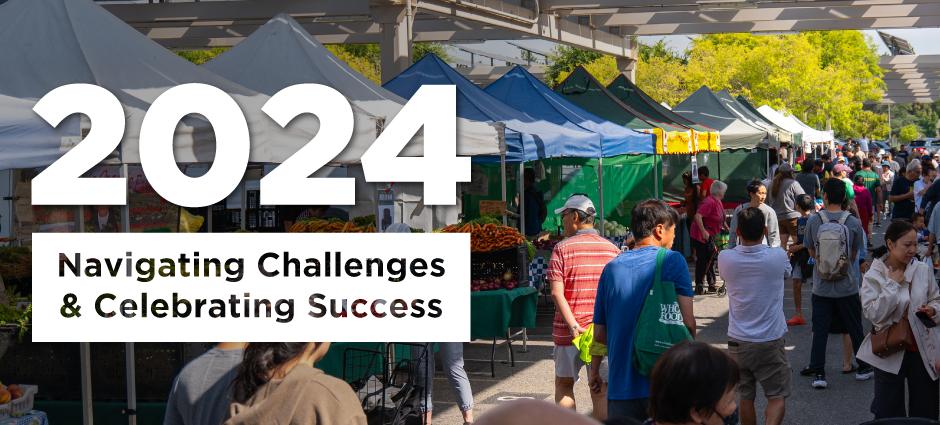Food Assistance and Farmers: Presentation to the California State Board of Food and Agriculture
On March 2, 2021, PCFMA's Executive Director, Allen Moy, was invited to speak to the California State Board of Food and Agriculture as part of the panel on Food Assistance and Farmers. The goal of the panel was to share examples of ways in which small-scale farmers and farmers' markets stepped up to address community food needs during the pandemic, and ways in which these farms and farmers' markets were impacted by the pandemic. Included below is the presentation that Allen provided.
Secretary Ross, Mr. Cameron, Members of the Board, Mr. Eddy – Thank you for this opportunity to speak to you today, alongside my colleagues on this panel, concerning the impact of the COVID-19 pandemic on our state’s certified farmers’ markets, and our state’s direct marketing farmers.
I want to begin by thanking Secretary Ross and the California Department of Food and Agriculture for your support, very early in the pandemic, that helped to ensure that farmers’ markets were named as essential services, alongside other food retail sites such as grocery stores. Had that designation not been made in March of 2020, the story that I have to share would undoubtedly be very different.
The Pacific Coast Farmers’ Market Association is a 32-year-old organization that is recognized by the IRS as a 501c5 agricultural nonprofit. Nearly 18 years ago, I joined the staff of PCFMA, and six years ago, I had the great honor of being asked to step into the role of Executive Director. I can tell you from that experience that 2020 was a year like no other for farmers’ markets.
In 2019, PCFMA operated 50 certified farmers’ markets per week in six counties of the San Francisco Bay Area. The week before the first shelter-in-place orders were issued in March of 2020, we were operating 33 year-round farmers’ markets and were actively planning to reopen 17 seasonal markets over the coming months. The week that the shelter-in-place orders went into effect, we were only able to keep 18 of those 33 markets open, while the rest were forced to close.
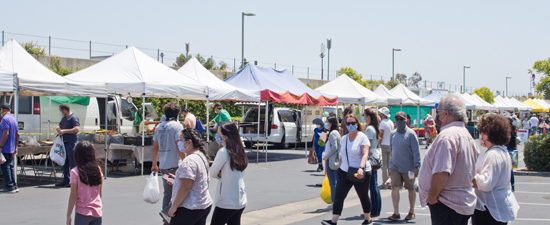
Among the farmers’ markets that PCFMA was forced to close were those that we operated in partnership with Bay Area hospitals including Kaiser Permanente and the VA. This was understandable as those hospitals began to deal with an influx of COVID patients and took significant steps to physically separate their patients fighting COVID from those uninfected. But that list of markets forced to close also includes several that were completely separate from our hospital partners. In most cases the property owner was not comfortable with a farmers’ market, or any event that brought people together, operating on their property.
Over the coming months, we were slowly able to reopen some of our year-round farmers’ markets that were closed in March, and in May and June, we were able to open most of our seasonal farmers’ markets. At our peak in September, we operated 30 markets per week.
Getting those markets open and keeping them open meant rethinking nearly every aspect of how we operate farmers’ markets. Anything not directly related to selling food was eliminated – music, kid’s activities, educational events, craft vendors, and even printed recipes at the information booth. In many cases, hot food vendors were not allowed. And, the market’s footprint had to change to allow empty spaces between each vendor, and lines had to be established to enforce social distancing at each vendor’s stall.
The economic model used by PCFMA and most farmers’ markets in Northern California is based upon selling space. At PCFMA, depending on the season, a farmer pays $32 to $52 per week, for every 10-foot by 10-foot space they occupy. The combination of factors that I described – fewer markets operating, certain classes of vendors not allowed to sell, and the requirement that we maintain empty spaces between vendors – had a direct impact on PCFMA’s finances. Our stall fee revenue dropped by more than 25% between 2019 and 2020. With fewer markets operating we were able to hire fewer seasonal market managers, but every market that remained open required more on-site staff to help enforce the new safety protocols. So while the income from our markets dropped 25% we were only able to cut our wage expenses for our farmers’ markets by 18%. To make up the difference we had to make cuts in other areas, especially our marketing efforts. We were forced to reduce hours for our marketing staff, reducing those wage costs by over 30%. We also eliminated planned marketing programs, spending less than half on marketing expenses in 2020 than we did in 2019.
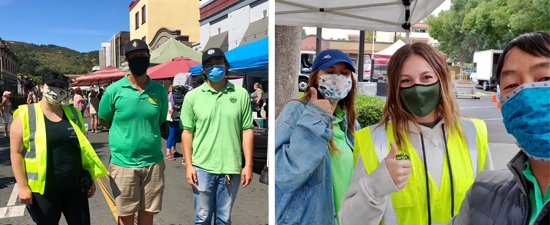
I want to acknowledge that these choices had a direct impact on PCFMA staff members. Reduced hours meant reduced pay. Our staff has stuck it out, even under adverse conditions when dealing with farmers’ market customers who thought our safety rules were an infringement upon their personal rights, as well as customers who thought that our inability to legally force someone to wear a mask meant that we were condoning unsafe behavior. I am in awe of the strength and resilience that our staff demonstrated and I thank them for their ongoing commitment to PCFMA and our mission.
Core to PCFMA’s mission is the belief that farmers’ markets are for everyone. That means that we believe that all communities, regardless of their economic means, should have access to fresh, California-grown, affordable, and culturally-appropriate fruits and vegetables. And we believe that the most sustainable way to provide that food access is through farmers’ markets. It is in those markets where farmers are best able to receive fair compensation for the food they produce, which means that they are best able to sustain their farm operations.
It has long been a policy at PCFMA that as a condition of selling in our farmers’ markets, all farmers must agree to accept all public benefit programs. Every PCFMA farmers’ market is enrolled in the federal SNAP program, or CalFresh, and the Farmers Market Nutrition Program.
Over the past decade, CalFresh spending at PCFMA’s farmers’ markets has increased dramatically, due in large part to our participation in the California Market Match Consortium[1]. Market Match is a statewide program that matches CalFresh spending at farmers’ markets, dollar-for-dollar, up to a daily limit which is usually $10.

It is important to recognize that CDFA long been an integral partner in Market Match. The program launched in 2009 with support from a CDFA specialty crop block grant and that grant program was one of the primary sources of funding for Market Match for the next several years.
In 2017, the California Nutrition Incentive Program was established by Assembly Bill 1321[2], authored by Assemblymember Phil Ting which, for the first time, invested state general funds into statewide nutrition incentive programs.
Today Market Match is funded primarily through a combination of funds from the California Nutrition Incentive Program, and the federal Gus Schumacher Nutrition Incentive Program[3]. That funding is administered through the CDFA Office of Farm to Fork[4] and implemented through a number of contractors, with the largest contract supporting direct marketing at farmers’ market through the Market Match Consortium, which is managed by the Berkeley-based Ecology Center.
I provide this history to recognize and celebrate the essential role that CDFA plays in this program, but also to emphasize that when we say that 2020 was an unprecedented year for Market Match, we have the data to back that up.
In 2020, PCFMA distributed over $533,000 worth of CalFresh benefits in its farmers’ markets. This is an increase of 65% from 2019.
Market Match saw a similar increase, hitting nearly $399,000. This was a 55% increase over the previous year. If I look at just PCFMA’s farmers’ markets that were open in both 2019 and 2020, the change is even more dramatic: a 70% increase in CalFresh and a 60% increase in Market Match. Together, CalFresh and Market Match spending increased by more than $350,000 at PCFMA’s farmers’ markets last year.
Other farmers’ markets from around the state reported a similar experience. Statewide, CalFresh at farmers’ markets in the Market Match Consortium increased by 53% to nearly 4.75 million dollars in 2020. Market Match also saw a tremendous increase of 44% to 3.1 million dollars. This combined spending totaled nearly $8 million last year. Those programs provided enormous support to the farmers who sell in our state’s farmers’ markets, and to the communities those farmers’ markets serve.
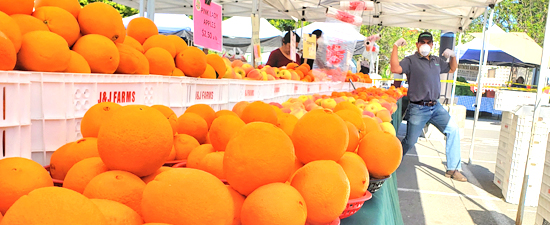
A study by Colorado State University[5] released earlier this year, shows that incentive programs in a farm-direct setting, like Market Match, have the highest economic multiplier of 3.0. That means for every $1 of incentives spent at a farmers’ market, it generates $3 of additional spending in the local economy
All of us in the Market Match Consortium are proud of the way in which we were able to rally together and help make Market Match part of the solution to the economic crisis caused by the pandemic. But we are worried about having the resources to sustain Market Match throughout the recovery, especially if the predictions of K-shaped recovery prove true, as that would mean that those with the fewest resources will continue to have the highest need. We believe that the time to prepare for that future is now, and we are working to request an appropriation of $20 million in the state’s general fund that will be used to pull down an equal amount of federal dollars to support Market Match for an additional 3-year period once the current funding ends.
Market Match is just part of the story of how farmers’ markets responded.
Over the past several weeks, I have had the opportunity to talk with my colleagues operating farmers’ markets at other organizations in Northern California. Many of them described their efforts to assemble and sell CSA-style boxes that brought together products from multiple farmers.
CUESA[6], which operates the Ferry Plaza Farmers’ Market, sold over 3,500 boxes which translates into over $160,000 of produce sales from its farmers. In addition, private donations made free boxes available to persons who would normally work in the hospitality industry but who were unemployed due to the shutdown of travel and tourism. That effort created an additional $65,000 in sales for farmers.
The Agricultural Institute of Marin[7], or AIM, which operates 7 markets in the Bay Area, offered curbside pickup of its Bounty Boxes, averaging around 300 boxes per week at 3 of their markets. CalFresh customers were among those buying Bounty Boxes. Over 550 CalFresh customers purchased boxes, using their Market Match benefits to receive a discount off of the $30 price.
North Coast Growers Association[8] which operates 9 farmers’ markets in Humboldt County, created Harvest Boxes that were available at community centers and resource centers, in addition to being available at the farmers’ market. This effort returned over $32,000 to local farmers.
Like PCFMA, North Coast saw a drop in revenue due to the pandemic. They reported that their stall fee revenue dropped nearly 30% while staff time and other expenses increased by nearly 25%.
The experience of PCFMA and North Coast is not unique. Farmers’ markets around the nation were impacted by the pandemic. A survey of markets by the National Farmers Market Coalition found 61% of farmers’ markets reported a drop in income in the summer of 2020, compared to the summer of 2019.
North Coast made it through the year through donations and in-kind assistance from local individuals and businesses that helped their markets get the safety resources they needed to continue to operate. AIM and CUESA similarly were able to reach out to their supporters for donations that helped to support their operations and provided the resources needed to innovate. But not all farmers’ markets were able to do so. Many farmers’ markets are organized as member-based associations, which means they are not recognized as 501c3 organizations, but instead fall under a different section of the tax code. This difference makes it much more difficult for them to raise donations, and in some cases, meant that they were ineligible for federal support through the HEROES or CARES Acts.
A common thread that I heard from CUESA, AIM, and North Coast is that many smaller-scale and family farmers would not have made it through 2020 without farmers’ markets. When restaurant and institutional sales abruptly ended, those farmers relied upon farmers’ markets to sell their harvests.
The past year has clearly demonstrated that farmers’ markets are essential. They kept fresh food flowing into our state’s urban areas while keeping sales dollars flowing into our state’s agrarian areas. The past year has shown that farmers’ markets are innovative, as they quickly revamped or built from scratch processes to safely operate in a very challenging environment.
But the past year has also demonstrated that farmers’ markets are vulnerable and need ongoing support. If we value the sustainability of our state’s small-scale and family farms that comprise the bulk of our state’s direct marketing farms, then we must invest into sustaining a strong and resilient network of certified farmers’ markets throughout the state, to provide outlets for those farmers.
Thank you again for the opportunity to speak to you today and for your consideration of these issues.
